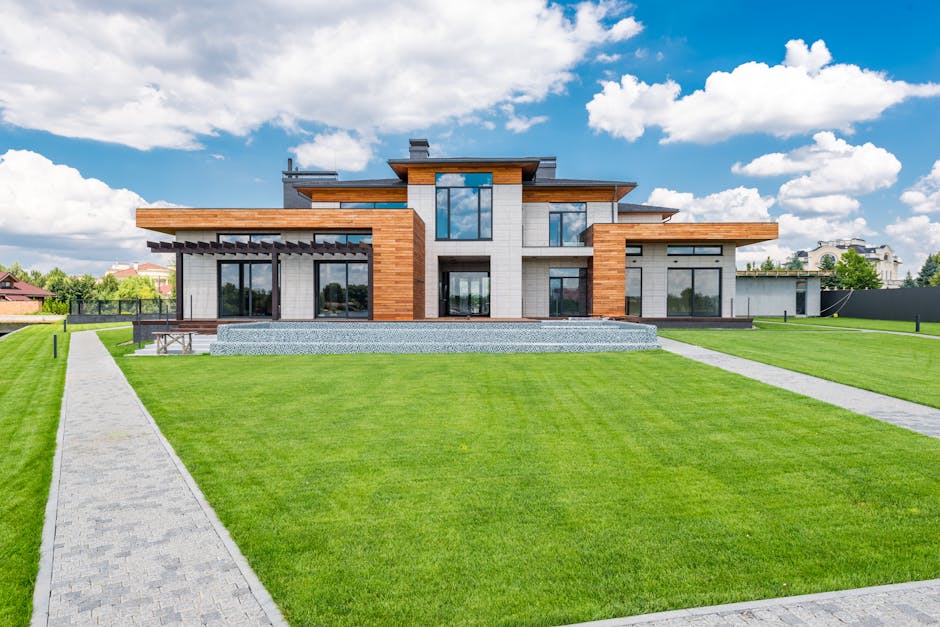Why Your Home’s Underground Lifeline Matters
A new sewer line might not be something you think about until problems arise, but this critical system quietly transports wastewater from your home to the municipal sewer system every single day. When your sewer line fails, it affects your entire household’s plumbing functionality and can cause serious damage to your property.
Key indicators you need a new sewer line:
- Frequent backups in multiple drains throughout your home
- Persistent sewage odors in your yard or basement
- Soggy spots or unusually green grass patches in your lawn
- Gurgling sounds from toilets and drains
- Foundation cracks caused by water seepage
- Multiple slow drains that won’t clear with normal cleaning
Most homeowners in Riverside and San Bernardino counties don’t realize their sewer lines can last 50-100 years depending on the material, but older homes with cast iron or clay pipes often need replacement sooner. Tree roots, soil shifting, and normal wear can cause pipes to crack, collapse, or become severely clogged.
The good news? Modern installation methods like trenchless technology can replace your sewer line with minimal disruption to your landscaping and daily routine. Traditional excavation remains necessary in some cases, but both methods can restore your home’s plumbing system to full functionality.
Understanding when and how to replace your sewer line protects your home’s value and prevents costly water damage from sewage backups.
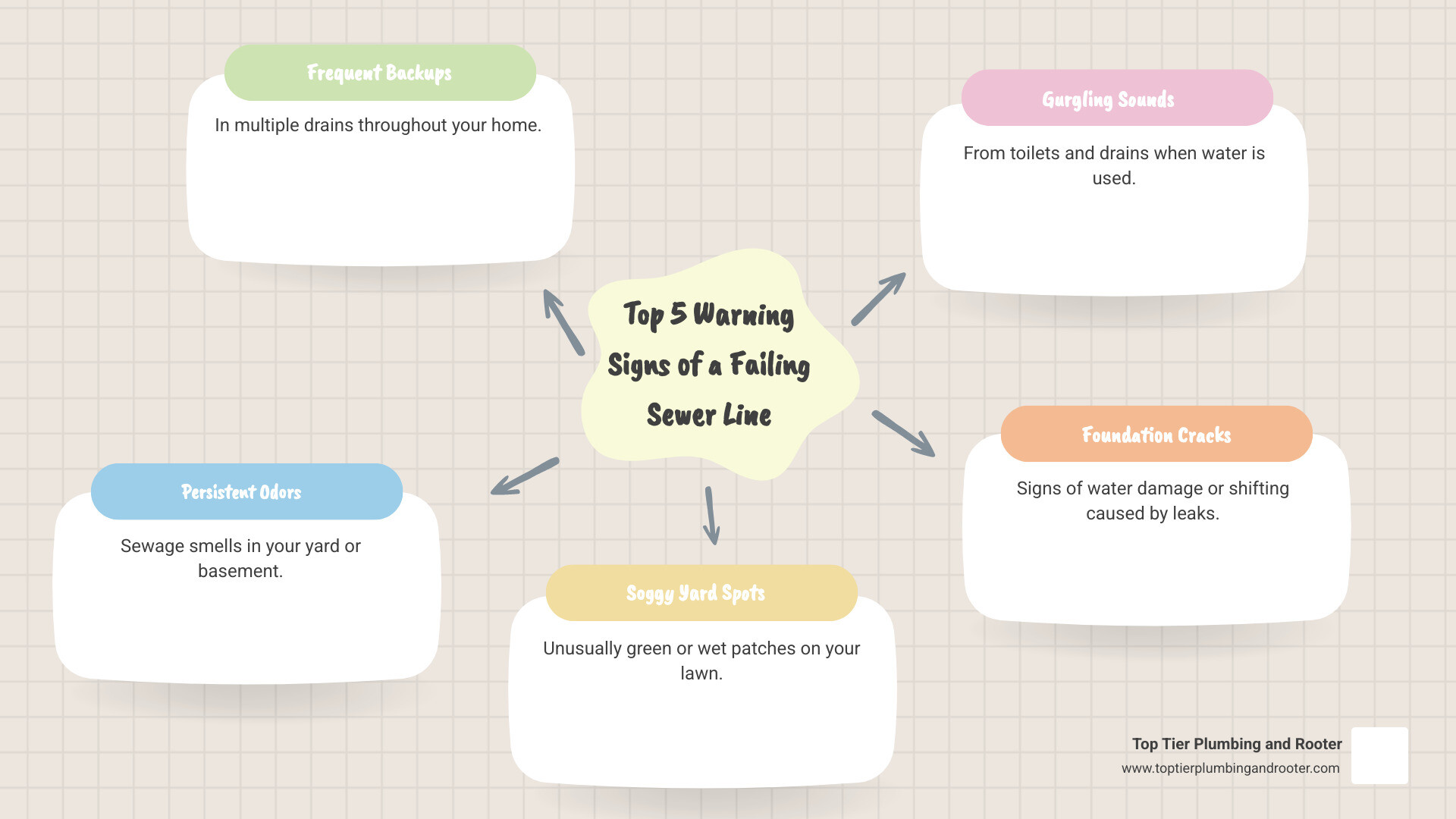
When to Consider a Replacement: Telltale Signs of a Failing Sewer Line
Your home’s sewer line works tirelessly, but it won’t last forever. Understanding when it’s time for a new sewer line can save you from messy surprises and expensive emergency repairs.
The lifespan of your sewer line depends on its material. Cast iron pipes can last 25 to 100 years, clay pipes about 50-60 years, and modern PVC pipes well over a century. However, factors like soil conditions, tree growth, and original installation quality can affect these timelines.
Frequent clogs in multiple drains are a primary red flag. When you’re constantly battling slow drains throughout the house, the problem is likely your main sewer line.
Strange gurgling sounds from toilets and drains indicate trapped air from blockages in your plumbing system.
Sewage backups are the most urgent warning. If raw sewage backs up into sinks, tubs, or toilets, you have a serious emergency requiring immediate professional attention. For guidance, see our article on Sewer Clearing Emergency: How to Identify and Address Urgent Sewage Issues.
Persistent foul odors around your property signal underground trouble. These sewage gases contain compounds that can be harmful to your health when they escape from damaged pipes.
Your yard can also reveal problems. Soggy spots or patches of unusually lush grass often indicate an underground leak, as escaping wastewater fertilizes the area above the damaged pipe.
Don’t overlook foundation cracks or settling. Severe sewer line leaks can saturate the soil, leading to erosion and structural issues.
Even increased pest activity, such as rodents and sewer gnats, can be drawn to moisture from compromised pipes.
Common Causes of Sewer Line Damage
Understanding why sewer lines fail helps you recognize when a new sewer line is your best option. In Riverside and San Bernardino counties, we see several common culprits.
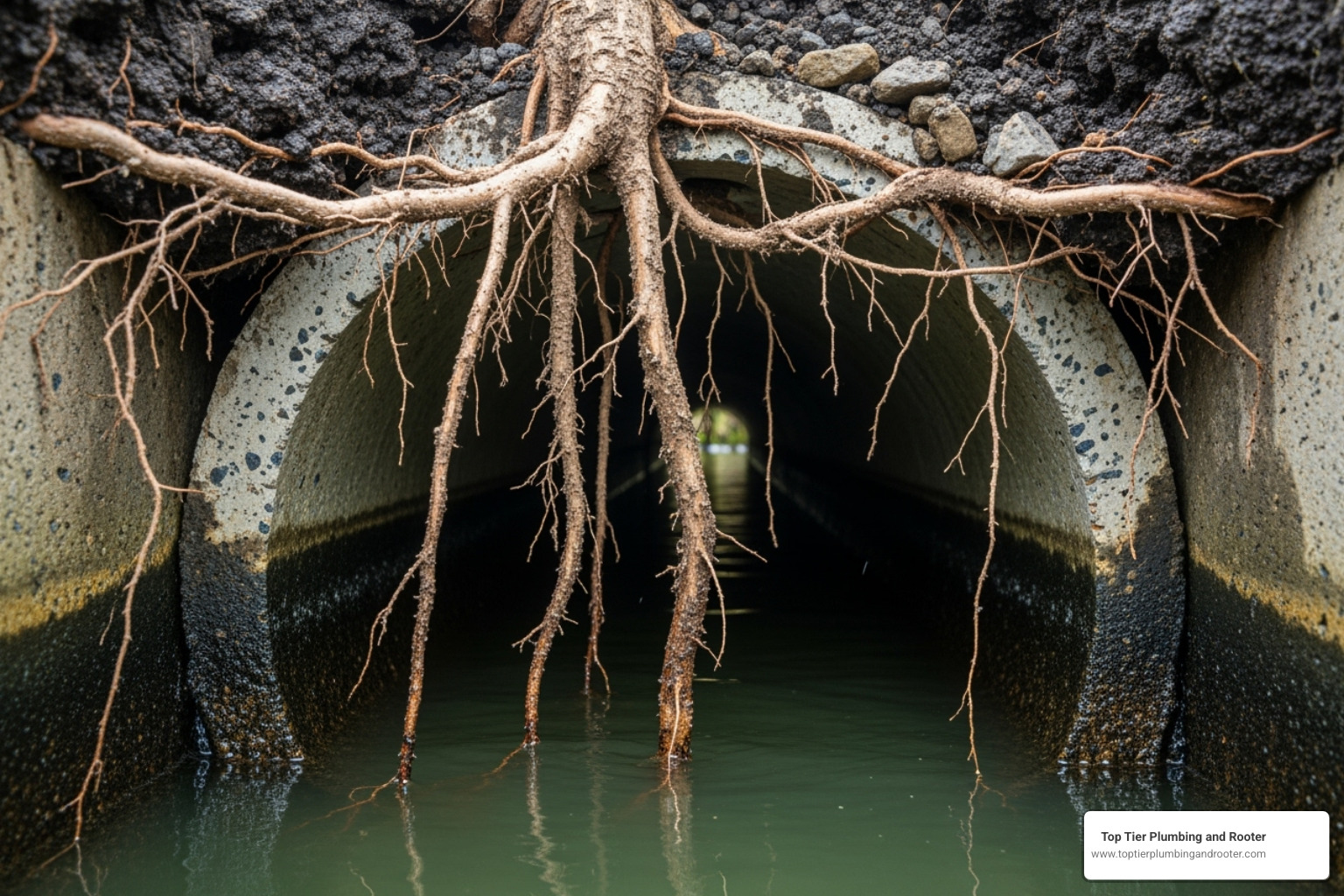
Tree root intrusion is a primary cause of damage. Roots seek water and can enter pipes through the smallest cracks, expanding and causing severe blockages.
Old pipe materials are prone to failure. Cast iron corrodes, clay pipes crack under pressure, and Orangeburg pipes (made of wood fiber and tar) deteriorate and collapse.
Shifting soil in Southern California can cause pipes to crack, disconnect, or develop offsets.
Clogs from grease and debris, if not addressed, can cause pressure and backups that stress your entire sewer system. Learn more in our guide Why Do I Have a Clogged Sewer Line?
The Diagnostic Step: Sewer Camera Inspections
Before recommending a new sewer line, we always start with a diagnosis using sewer camera technology to ensure you get the right solution.
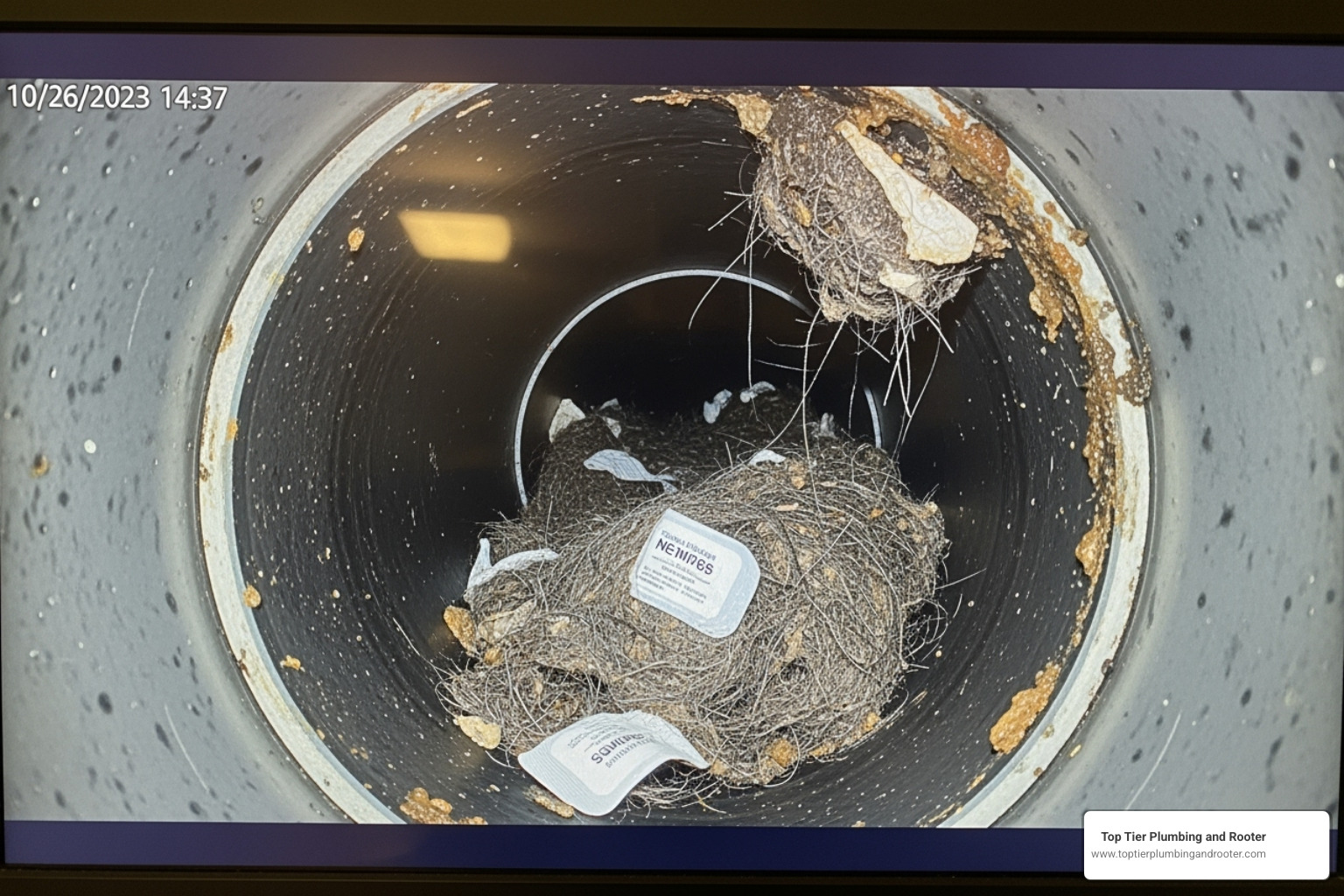
Our non-invasive diagnosis uses a high-resolution camera inserted into your pipes via a cleanout. This provides a real-time video feed of the pipe’s interior, eliminating guesswork.
The camera pinpoints the exact location and nature of the damage, from cracks and root intrusion to collapses, allowing for precise repairs.
Assessing pipe condition with a camera helps us spot signs of aging, corrosion, or weak spots that might become future problems.
This inspection helps us determine the best repair method. Visual evidence ensures you get the most appropriate and cost-effective solution, whether it’s a targeted repair or a complete new sewer line.
This diagnostic approach saves time, money, and disruption. Learn more in our article about The Role of Video Inspection in Sewer and Drain Repair.
Deciding on a New Sewer Line: Trenchless vs. Traditional Installation
When a camera inspection reveals significant damage, it’s time to consider a new sewer line. You have two main options: trenchless and traditional installation. Choosing the right one depends on your specific situation.
| Feature | Trenchless Sewer Repair | Traditional Excavation |
|---|---|---|
| Disruption | Minimal; typically only two small access points | Substantial; involves digging a trench along the entire line |
| Time | Faster; often completed in 1-2 days | More time-consuming; can take 3-5 days or more |
| Durability | Creates a new, seamless pipe within the old; rated for 50+ years | New pipe installation; longevity depends on material |
| Application | Best for cracks, root intrusion, minor offsets | Necessary for collapsed, back-pitched, or extensively damaged pipes |
The right choice depends on several factors. Pipe condition is the most important; trenchless methods work well for cracked or root-invaded lines, but a collapsed or back-pitched pipe requires excavation. Property layout also matters, as trenchless methods can save landscaping and driveways. While trenchless may have a higher upfront cost, it avoids the additional expense of restoring your property, which can make it more cost-effective overall.
The Modern Method: Trenchless Sewer Repair
Trenchless sewer repair is a modern method that avoids major excavation. We can install your new sewer line through just two small access points.
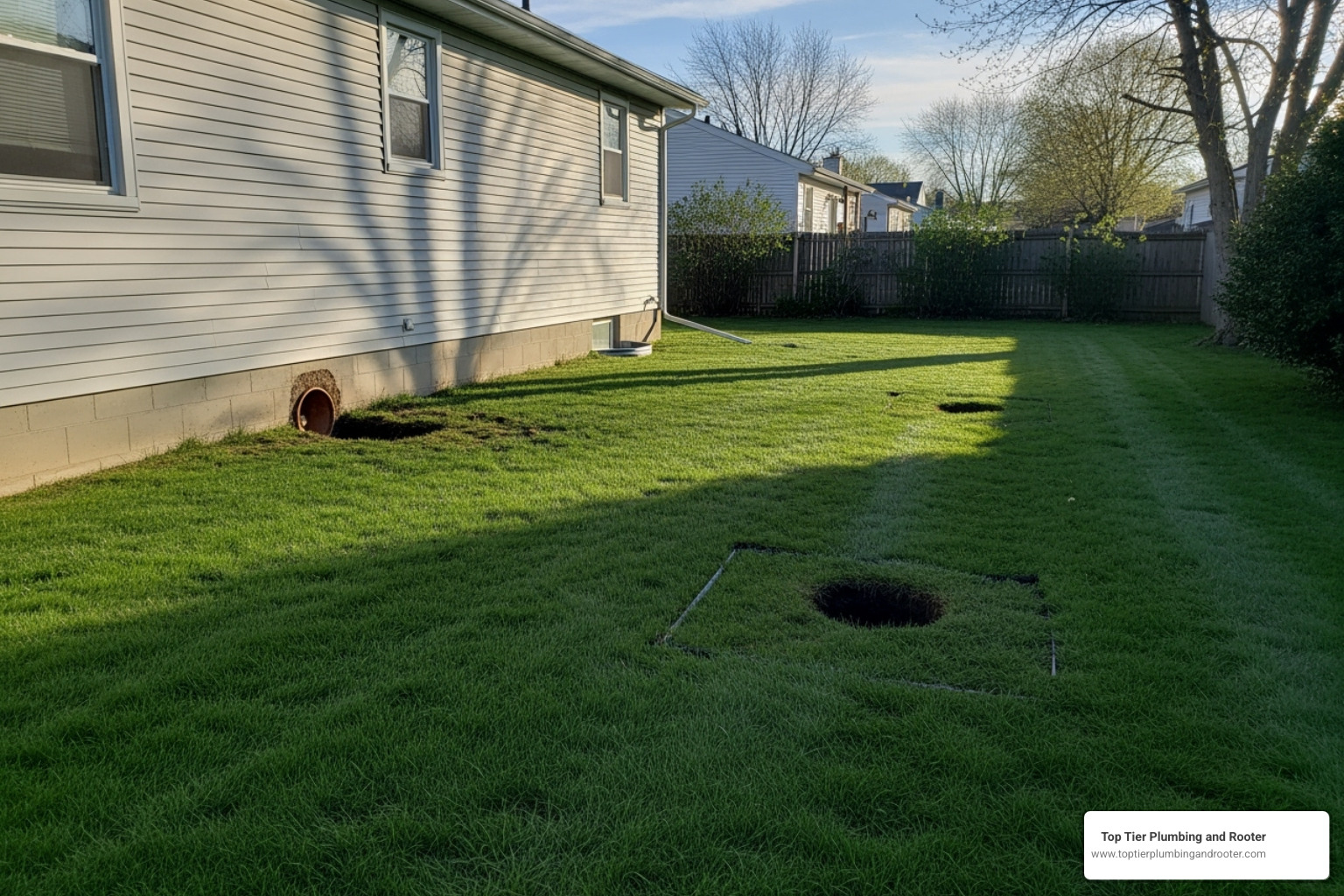
This method offers minimal disruption to your property and daily life. It preserves your landscaping and driveways because there is no major excavation. The faster completion time is another advantage, with most installations finished in one to two days.
The result is a durable, seamless new pipe resistant to root intrusion and corrosion, with a lifespan of 50 years or more. We specialize in trenchless techniques like pipe lining and pipe bursting, choosing the best fit for your situation. Learn more in our guides on Trenchless Sewer Repair and The Benefits of Trenchless Sewer Repair: Why It’s a Game Changer for Homeowners.
The Classic Method: Traditional Excavation
While trenchless technology is often preferred, traditional excavation is sometimes necessary for a proper new sewer line installation.
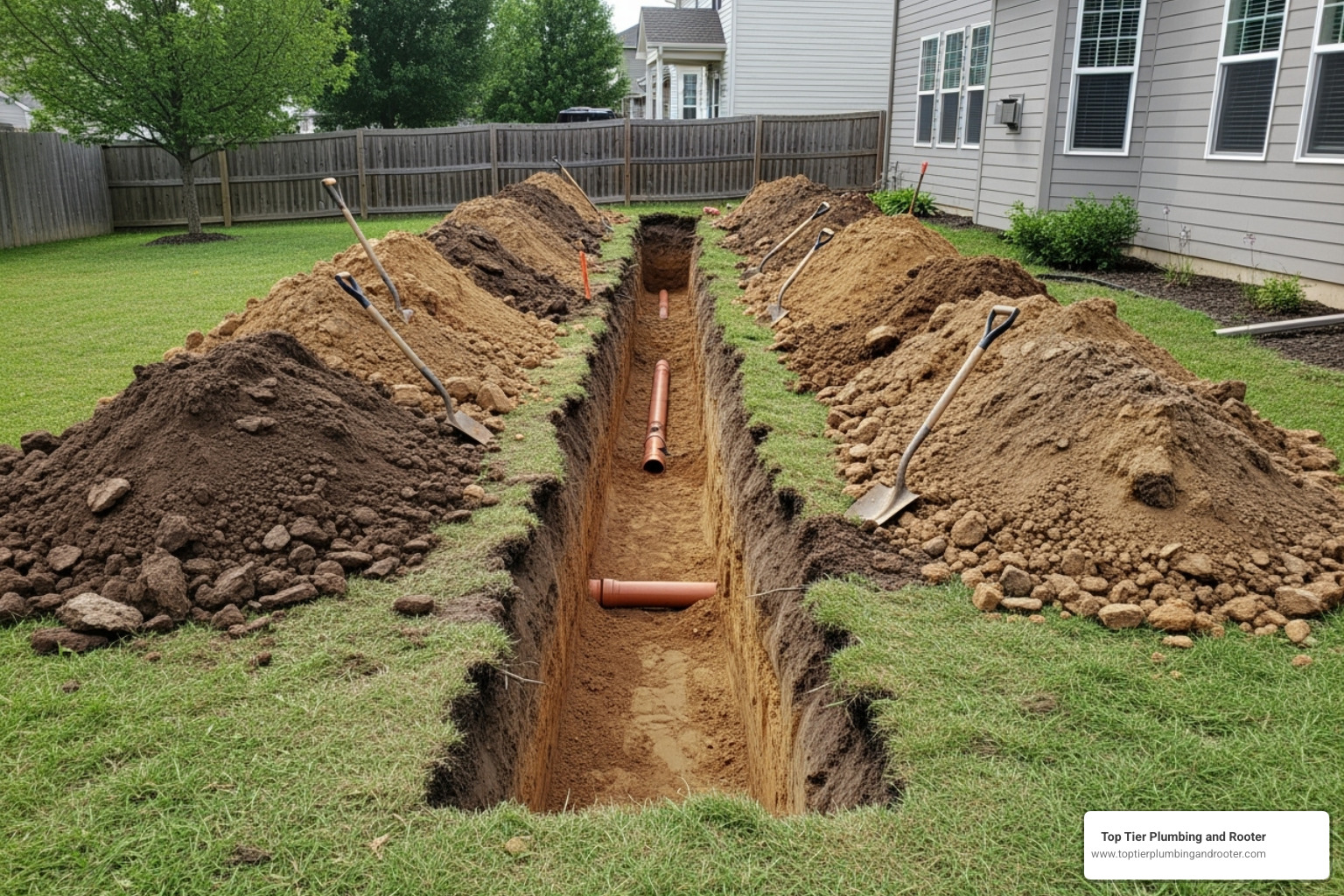
Complete pipe removal is the only solution when a line has deteriorated beyond repair, such as with collapsed pipes or those made from materials like Orangeburg. This method provides direct access to pipes to address surrounding issues like unstable soil or large root systems.
Traditional excavation is suitable for collapsed lines and back-pitched pipes. This method is required when a pipe has caved in or slopes the wrong way, as these structural issues cannot be fixed internally.
The main trade-off is the disruption to your property, including digging up landscaping and driveways. However, it is sometimes the only way to achieve a reliable, long-lasting solution. When excavation is necessary, we handle the entire process, including restoration. Learn more about our approach to Sewer Drain Repair.
The Installation Process Step-by-Step
Installing a new sewer line requires professional expertise, specialized equipment, and knowledge of local codes. We handle the entire process to ensure it meets all safety and municipal standards.
Before work begins, we manage critical preparations. Permit requirements are essential in Riverside and San Bernardino counties, and we handle all paperwork to ensure compliance. Utility line location is another key safety step. We call 811 to have underground gas, water, and electrical lines marked before any digging begins.
The Process for Installing a New Sewer Line with Trenchless Technology
If trenchless repair is right for your new sewer line, the process is remarkably smooth.
- Pipe Cleaning: The process begins with pipe cleaning using powerful hydro-jetting to remove debris, grease, and roots. This ensures the new liner adheres properly to the existing pipe.
- Creating Access Points: Instead of a trench, we dig two small access points at each end of the damaged pipe section.
- Inserting the Liner: We insert a flexible, epoxy-saturated liner into the old pipe. This liner acts as a mold for the new pipe.
- Inflating and Curing: An inflatable bladder presses the liner against the old pipe’s walls. During the curing process, the epoxy resin hardens, creating a durable, seamless pipe-within-a-pipe rated to last 50+ years.
- Final Inspection: We conduct a final camera inspection to confirm the new sewer line is perfectly installed. We then backfill the access points and restore your property.
Learn more about this approach in The Benefits of Trenchless Sewer Repair for Your Home or Business.
Steps for a Traditional New Sewer Line Replacement
When traditional excavation is necessary, the process is more involved but equally thorough.
- Marking the Line: Using camera inspection data, we accurately mark the path for excavation.
- Excavating a Trench: We dig a trench along the marked line to the required depth, providing full access to the damaged pipe.
- Removing the Old Pipe: All damaged sections of the old line are carefully removed, which is essential for collapsed or deteriorated pipes.
- Laying New Pipe: We install modern, durable PVC or HDPE pipes, which are resistant to corrosion and root intrusion.
- Ensuring Proper Slope: This is a critical step. We grade the new pipe with the correct downward slope (typically 1/4 inch per foot) so gravity can carry wastewater away effectively.
- Connecting to the System: The new pipe is expertly connected to your home’s plumbing and the municipal sewer main.
- Backfilling and Restoration: We carefully backfill the trench, compacting the soil in layers to prevent future settling. Finally, we restore the work area, coordinating any necessary landscaping.
Protecting Your Investment: Maintaining Your New Sewer Line
Installing a new sewer line is a smart investment. To ensure it serves your family for decades, some simple maintenance is required. Preventative measures and smart daily habits can extend your pipe’s lifespan and help you avoid emergency repairs.
Taking care of your new sewer line is mostly about what you don’t put down your drains.
- Never flush these items: So-called “flushable” wipes, paper towels, feminine hygiene products, cotton balls, dental floss, or cat litter. These items do not break down and will cause clogs.
- Practice proper grease disposal: Never pour cooking grease or oil down the sink. It solidifies in pipes and causes severe blockages. Let it cool in a disposable container and throw it in the trash.
- Use your garbage disposal wisely: Avoid fibrous foods (celery, potato peels), coffee grounds, and eggshells, as they can create clogs and debris.
Even though your new sewer line is root-resistant, be mindful of landscaping. Keep large trees a safe distance from the sewer line path to prevent future root problems.
Regular inspections with a sewer camera are like a health checkup for your plumbing. An annual or bi-annual inspection can catch small issues before they become major problems, especially if you have mature trees nearby.
Professional hydrojetting is another excellent maintenance tool. This powerful cleaning method removes any buildup that accumulates over time, keeping your pipes flowing smoothly.
By following these guidelines, you protect your investment and ensure reliable plumbing for years. For more tips, see our guide on The Importance of Regular Drain Cleaning in Riverside and San Bernardino County Homes.
Frequently Asked Questions about New Sewer Lines
It’s natural to have questions when facing a new sewer line installation. Here are answers to the most common ones we hear from homeowners in Riverside and San Bernardino counties.
How long do new sewer lines last?
The lifespan of a new sewer line depends on the material, and modern options are incredibly durable.
- PVC pipes, the current standard, can last over 100 years. They are highly resistant to corrosion, roots, and chemical damage.
- HDPE pipes, often used in trenchless projects, have a similar lifespan and are excellent at handling ground movement.
- Trenchless liner installation (CIPP) creates a new pipe within the old one with a lifespan of 50+ years.
With professional installation, you are investing in decades of reliable service.
Is trenchless sewer replacement always an option?
Trenchless replacement is an excellent option, but its feasibility depends on your existing pipe’s condition.
Trenchless methods are ideal for pipes that are structurally sound but have cracks, leaks, or root intrusion. The existing pipe must be stable enough to host the new liner or pipe.
However, trenchless is not an option for pipes that have completely collapsed, are crushed, have severe offsets, or are back-pitched (sloping the wrong way). These issues require excavation to correct.
This is why a sewer camera inspection is always our first step. It allows us to see the exact condition of the pipe and recommend the correct solution.
Do I need a permit to install a new sewer line?
Yes, permits are required for a new sewer line installation in Riverside and San Bernardino counties, and we handle the entire process for you.
Municipal regulations and the required inspection process ensure the work meets all safety and building codes, protecting public health and your investment.
Code compliance is important for insurance purposes and maintaining your home’s value. We manage all paperwork and coordination with local authorities to ensure your project is fully compliant.
Your Partner for a Healthy Home Plumbing System
When your home’s essential sewer line fails, it can cause significant stress. Choosing the right method and the right team for your new sewer line project is critical.
Facing sewer line problems can be overwhelming. We guide you through the process with clear explanations and honest recommendations custom to your situation.
The importance of professional installation for your new sewer line cannot be overstated. It’s about having the experience and technology to ensure your new system will serve your family reliably for decades.
Investing in a new sewer line is about ensuring long-term reliability. A professional installation prevents sewage backups, protects your foundation, and eliminates foul odors. It also protects your property value, as documented professional work is a major asset.
At Top Tier Plumbing and Rooter, we have a reputation for providing reliable plumbing solutions to homeowners throughout Riverside and San Bernardino counties. We’ve handled every type of sewer line challenge, from aggressive tree roots to shifting soil.
Our commitment is to do the job right the first time. Whether your situation calls for advanced trenchless repair or traditional excavation, we will explain your options clearly to help you make the best decision for your home and budget.
Don’t let sewer line worries disrupt your life. If you notice warning signs like slow drains, strange odors, or soggy spots in your yard, it’s time to get answers.
Schedule Your Professional Sewer Cleaning Today and let us help you keep your home’s underground lifeline flowing smoothly.


